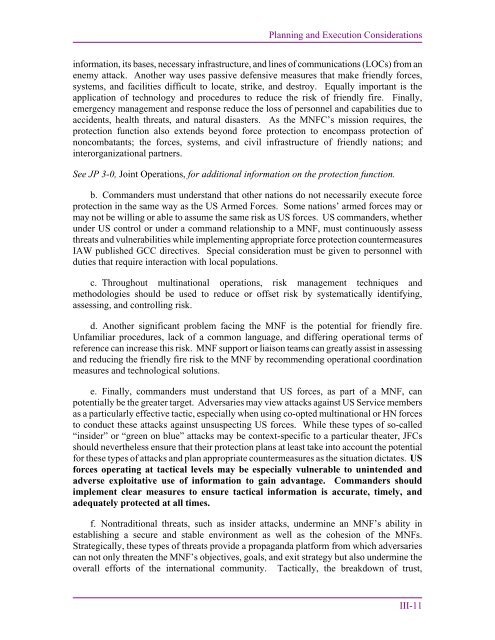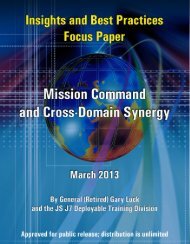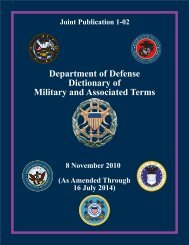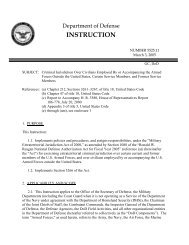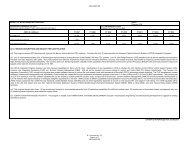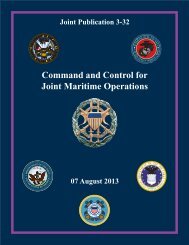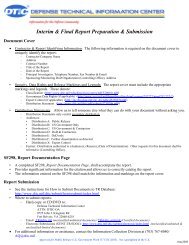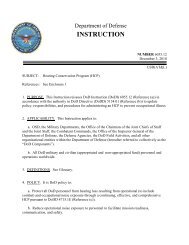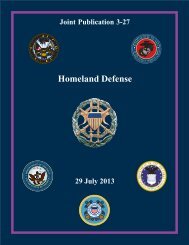JP 3-16, Multinational Operations - Defense Technical Information ...
JP 3-16, Multinational Operations - Defense Technical Information ...
JP 3-16, Multinational Operations - Defense Technical Information ...
You also want an ePaper? Increase the reach of your titles
YUMPU automatically turns print PDFs into web optimized ePapers that Google loves.
Planning and Execution Considerations<br />
information, its bases, necessary infrastructure, and lines of communications (LOCs) from an<br />
enemy attack. Another way uses passive defensive measures that make friendly forces,<br />
systems, and facilities difficult to locate, strike, and destroy. Equally important is the<br />
application of technology and procedures to reduce the risk of friendly fire. Finally,<br />
emergency management and response reduce the loss of personnel and capabilities due to<br />
accidents, health threats, and natural disasters. As the MNFC’s mission requires, the<br />
protection function also extends beyond force protection to encompass protection of<br />
noncombatants; the forces, systems, and civil infrastructure of friendly nations; and<br />
interorganizational partners.<br />
See <strong>JP</strong> 3-0, Joint <strong>Operations</strong>, for additional information on the protection function.<br />
b. Commanders must understand that other nations do not necessarily execute force<br />
protection in the same way as the US Armed Forces. Some nations’ armed forces may or<br />
may not be willing or able to assume the same risk as US forces. US commanders, whether<br />
under US control or under a command relationship to a MNF, must continuously assess<br />
threats and vulnerabilities while implementing appropriate force protection countermeasures<br />
IAW published GCC directives. Special consideration must be given to personnel with<br />
duties that require interaction with local populations.<br />
c. Throughout multinational operations, risk management techniques and<br />
methodologies should be used to reduce or offset risk by systematically identifying,<br />
assessing, and controlling risk.<br />
d. Another significant problem facing the MNF is the potential for friendly fire.<br />
Unfamiliar procedures, lack of a common language, and differing operational terms of<br />
reference can increase this risk. MNF support or liaison teams can greatly assist in assessing<br />
and reducing the friendly fire risk to the MNF by recommending operational coordination<br />
measures and technological solutions.<br />
e. Finally, commanders must understand that US forces, as part of a MNF, can<br />
potentially be the greater target. Adversaries may view attacks against US Service members<br />
as a particularly effective tactic, especially when using co-opted multinational or HN forces<br />
to conduct these attacks against unsuspecting US forces. While these types of so-called<br />
“insider” or “green on blue” attacks may be context-specific to a particular theater, JFCs<br />
should nevertheless ensure that their protection plans at least take into account the potential<br />
for these types of attacks and plan appropriate countermeasures as the situation dictates. US<br />
forces operating at tactical levels may be especially vulnerable to unintended and<br />
adverse exploitative use of information to gain advantage. Commanders should<br />
implement clear measures to ensure tactical information is accurate, timely, and<br />
adequately protected at all times.<br />
f. Nontraditional threats, such as insider attacks, undermine an MNF’s ability in<br />
establishing a secure and stable environment as well as the cohesion of the MNFs.<br />
Strategically, these types of threats provide a propaganda platform from which adversaries<br />
can not only threaten the MNF’s objectives, goals, and exit strategy but also undermine the<br />
overall efforts of the international community. Tactically, the breakdown of trust,<br />
III-11


